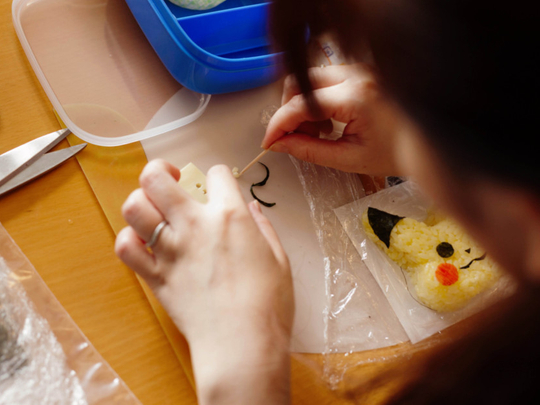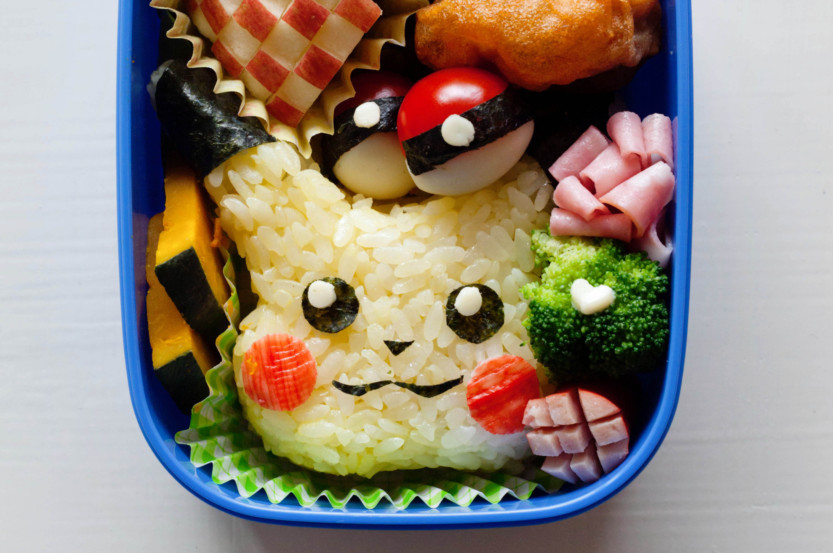
In Japan, the packed school lunch has been elevated to an art form.
Every morning across this country, mothers — always mothers — wake up and make little boxes of delicious art for their children. Rice balls in the shape of pandas or bears, complete with eyes and smiles cut out from a sheet of dried seaweed, sausages carved to look like octopuses and fruit speared with cute animal toothpicks. And all nutritionally balanced, of course.
But some mums go the extra mile — or rather, the extra hour — to make a uniquely Japanese kind of lunchbox: the kyara-ben, or character bento. Think Hello Kitty or Doraemon the robot cat nestled in a bed of lettuce, a rice ball surrounded by a heart-shaped omelette and carrots cut into flowers.
“I’m here because I thought it would make my kids happy if I could make them cute bento,” said Saori Inokuchi, a 36-year-old mother of two children, ages 4 and 5, while attending a special class to learn to make more elaborate lunchboxes.
Inokuchi came along with her friend, Maya Minamisawa, who has three children, ages 8, 4 and 1, to learn from Tomomi Maruo how to make Pokémon-themed bento. Maruo offers kyara-ben lessons at her home through her company, Obento4kids, and also has a YouTube channel.
The women learnt how to shape rice into Pikachu, the yellow Pokémon rodent, how to make eyes from seaweed and cheese slices, and cheeks from crab sticks. They made Poké Balls by sticking half a cherry tomato to half a quail’s egg then wrapping a strip of seaweed around it, topped off with another cheese circle.
There were cheese hearts for the broccoli trees, and flowers made from sliced meat.
All in all, it took about an hour, although Maruo, the teacher, had already cooked the broccoli and squash for the box. As a pro, she can do the whole thing in 40 minutes.
Maruo started making kyara-ben boxes when her sons, now 13 and 16, were younger. “I wanted my kids to enjoy eating lunch at kindergarten,” she said.
Other mothers started asking her advice, kicking off a business that has had her offering kyara-ben lessons for the past 13 years. “Mums like to see their kids’ happy faces, and most mums enjoy making kyara-ben because it’s fun,” she said.
Kyara-ben are mainly made for children in preschool or kindergarten to help introduce them to a wide variety of foods and stop them from developing picky eating habits. This approach may have some merit: the vast majority of Japanese children happily eat grilled fish and steamed vegetables.
But the kyara-ben craze is also a symptom of the enormous expectations placed on women in a country notorious for creating hurdles to becoming a working mother.
The Japanese government cabinet office was sharply criticised for tweeting a link to a blogpost in which a mother wrote about making cute lunchboxes even when she’s tired or busy.
“Thanks to the smiles [I get from my son], making bento each day has become a time I enjoy,” Keiko Iwata wrote on the Cheering for Women blog, associated with the government’s “womenomics” efforts to getting more women into the workplace and let them “shine”.
Critics noted the contradiction between promoting the idea that women ought to be making such time-consuming lunchboxes at the same time as it’s trying to make it easier for women to work.
Many pregnant women are forced to leave their jobs, either because of “mata-hara” (maternity harassment) or because the relentless working culture is not compatible with family life. Japanese kindergartens in particular place a heavy burden on mothers — from sewing little bags for books and shoes to making cute lunchboxes.
There is no shortage of inspiration here.
The Japanese internet is full of photos of adorable kyara-ben, and there are hundreds of books devoted to the subject, with titles such as “Kyara-ben for First-timers: You Can Make Cute Kyara-ben Quickly on a Busy Morning!”
Homeware stores have shelves of moulds to easily press rice and even hard-boiled eggs into animal shapes, and supermarkets sell cute paper liners for boxes.
A cable channel show offers instruction on how to make kyara-ben inspired by the mascots that are ubiquitous in Japan, and there are even kyara-ben competitions where mothers vie to make the most breathtaking box. But sports days and other events where mothers are present — and can check out other kids’ bento boxes — often turn into a contest of their own.
This kind of pressure on mothers can cause plenty of headaches. One news report entitled “The cause is kyara-ben! A fight breaks out between mommy friends!” earlier this year described the envy that was fomenting between some mothers. Some kindergartens have even started banning kyara-ben for fear of bullying: children making fun of those with substandard lunchboxes.
There are certainly detractors. “I saw kyara-ben images on Facebook and realised they were made by mums who woke up at 4 or 5am. I am so glad I am not being a mum in Japan,” one woman wrote in Japanese on the popular recipe site Cookpad.
But Minamisawa and Inokuchi, neither of whom works outside the home, said they were inspired by the class.
“It was much easier than it looked,” Minamisawa said, although she noted Maruo had done most of the preparation. “It would be hard if I had to do everything from scratch.”
Most days, Minamisawa spends 15 or 20 minutes making a lunchbox for each of her older children, although more ambitious boxes take twice that. She is already thinking about making ghost-shaped rice balls for Halloween.
Inokuchi said she would use plastic wrap to form rice balls into shapes at home. “I want to work hard and make a cute bento,” she said. Minamisawa added: “When my kids come home with an empty bento box, it makes me really happy.”
–Washington Post













